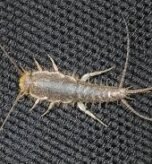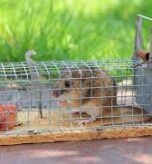Drain flies are a persistent nuisance in many homes and businesses. These small insects are drawn to the moisture and decaying organic gunk found in plumbing systems. To maintain a healthy and hygienic environment, you must understand their behavior and the most effective ways to get rid of them. This guide provides a complete overview of drain flies, from identification to long-term prevention.
Understanding Drain Flies
What Are Drain Flies?
Drain flies (Psychodidae family) are tiny insects, typically under a quarter-inch long. You can recognize them by their gray-to-black coloring and fuzzy, moth-like appearance. People also call them moth flies, sewer flies, or sink flies.
It is important to tell drain flies apart from other common household pests.
- Fruit Flies are drawn to ripe fruit and rotting vegetables, so you will often find them in the kitchen.
- Fungus Gnats prefer moist soil and usually hover around houseplants.
- Drain Flies, however, specifically breed in the bacteria, fungi, and organic slime that collects inside drains.
The Drain Fly Life Cycle and Habits
Drain flies undergo a complete metamorphosis from egg to adult. An adult fly lives for about two weeks, but a female can lay up to 300 eggs in that time. The eggs hatch quickly, and the entire life cycle can take anywhere from one to three weeks.
These insects thrive in damp, humid environments with plenty of organic debris. Common breeding sites include:
- Slow or clogged drains
- Infrequently used sinks or floor drains (e.g., in guest bathrooms or basements)
- Sewage systems and septic tanks
- Refrigerator drain pans
Drain flies are weak fliers. You will often see them crawling or hopping on surfaces near a drain rather than flying long distances. They are most active in the evening.
How to Identify a Drain Fly Infestation
Recognizing the signs of drain flies is key to effective control. The most obvious sign is seeing the small, furry-winged flies hovering around sinks, showers, or drains. You might also spot their larvae—tiny, semi-transparent worms—in the slimy film inside a drain.
Simple Diagnostic Tests
- Hand Wave Test: Wave your hand near a suspected drain. This will disturb any hidden flies, causing them to fly out.
- Tape Test: This is a very effective method. Place a piece of duct tape, sticky-side down, over a suspected drain overnight. If drain flies try to emerge, they will get stuck to the tape, confirming you have found an active breeding site.
Are Drain Flies Harmful?
While drain flies do not bite or sting, their presence can indicate underlying issues that pose health risks.
- Pathogen Carriers: Because they develop in unsanitary places like sewage, they can carry bacteria and other pathogens. When they land on food or countertops, they can contaminate these surfaces.
- Allergy Triggers: The fine hairs from their bodies, shed skins, and droppings can become airborne. Inhaling this dust can trigger allergies and worsen asthma symptoms in sensitive people.
- Indicator of Sanitation Problems: The presence of drain flies is a clear sign of a sanitation or moisture problem. The conditions that support them can also foster the growth of harmful bacteria and other pests.
Effective Strategies for Drain Fly Elimination
The most effective way to control drain flies is to eliminate their food source and breeding grounds.
Step 1: Clean the Breeding Sites
You must physically remove the sludge inside your drains and pipes.
- Manual Cleaning: Use a long-handled pipe brush or a drain snake to scrub the inside of the pipe and dislodge eggs, larvae, and organic buildup.
- Boiling Water: Pouring boiling water down the drain can help remove buildup and kill flies and larvae. Repeat this daily for a week. Caution: Hot water is safer for PVC pipes than boiling water, as repeated exposure to high heat can damage them.
- Baking Soda and Vinegar: Pour a mixture of ½ cup of baking soda and ½ cup of salt down the drain. Follow it with 1 cup of vinegar. The reaction will help break down organic matter. Cover the drain, let it sit overnight, and then flush with hot water.
- Enzyme Drain Cleaners: These cleaners use beneficial bacteria or enzymes to break down the organic slime that drain flies feed on. They offer a long-term solution by eliminating the core problem.
Step 2: Trap Adult Flies
Traps will not eliminate the source of the infestation, but they can reduce the adult population while you clean the drains.
- Apple Cider Vinegar Trap: Pour some apple cider vinegar into a dish, cover it with plastic wrap, and poke small holes in the top. Flies are attracted to the scent, get trapped inside, and drown.
- Commercial Fly Traps: Sticky traps or UV light traps can also be effective at capturing adult pests.
Step 3: When to Use Professional Solutions
- Chemical Cleaners: Commercial drain cleaners can clear stubborn clogs, but read labels carefully, as some are not safe for all pipe types.
- Insect Growth Regulators (IGRs): Pouring insecticides down the drain is not recommended. However, an IGR foam can interrupt the life cycle by preventing eggs from hatching.
- Call a Professional: If DIY methods fail or the infestation is severe, contact a professional pest control service or a plumber. They can accurately identify hidden breeding sites and apply more effective, targeted treatments safely.
How to Prevent Future Infestations
Preventing drain flies involves consistent sanitation and home maintenance.
- Clean all drains regularly to prevent organic buildup.
- Ensure your home, especially bathrooms and kitchens, is well-ventilated to reduce humidity.
- Fix any plumbing leaks or moisture problems promptly.
- Use sink and shower drain covers or stoppers when drains are not in use.
- Seal any cracks or gaps around windows, doors, and pipes where flies might enter from outside.



